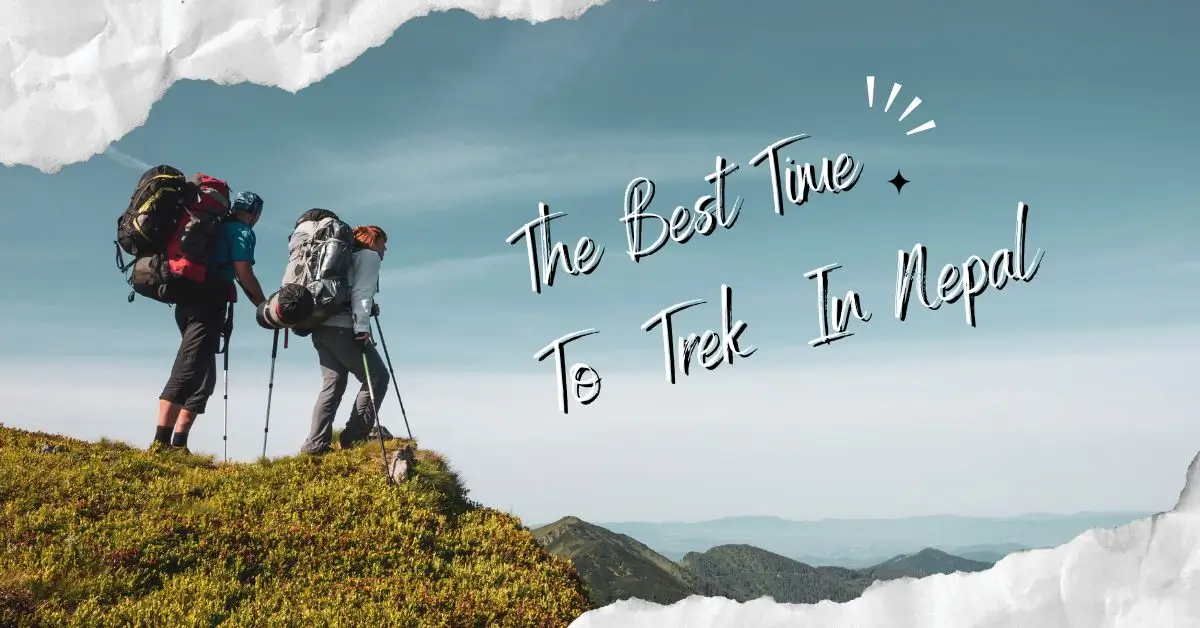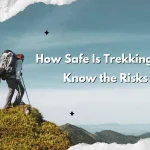If you are planning a Himalayan adventure, one of the first questions you will ask is, “When is Trekking Season in Nepal?” Choosing the right season for trekking can make or break your experience. The season not only determines the weather but also the visibility of the mountains, the safety of trails, and even how crowded or peaceful your trek will be.
Nepal is blessed with diverse climates, ranging from subtropical valleys to icy Himalayan passes. This makes trekking possible year-round, but each season offers very different conditions. In this detailed guide, we’ll explore the best trekking seasons in Nepal, answer common questions about different months, and help you decide the perfect time for your adventure.
Best Trekking Seasons in Nepal
The prime trekking seasons in Nepal are autumn and spring. These months are universally recommended because they combine the best weather, excellent visibility, and well-maintained trails.
Autumn (September–November): This is widely known as the classic answer to “When is Trekking Season in Nepal?” After the monsoon rains, the air becomes crystal clear, the skies are bright, and the mountain views are unparalleled. Temperatures are moderate, making trekking comfortable. Festivals like Dashain and Tihar fall in this season, allowing trekkers to experience vibrant Nepali culture.
Spring (March–May): The second-best trekking season in Nepal. Rhododendron forests burst into bloom, creating colorful trails, and long daylight hours provide plenty of time for trekking. Temperatures are slightly warmer than in autumn, and many expeditions to climb Everest also happen in spring.
Winter (December–February): For those seeking solitude, winter trekking is a hidden gem. If you are still asking “When is Trekking Season in Nepal?” then winter can be a surprisingly good choice for peaceful low- and mid-altitude treks. The air is crisp, skies remain clear, and trails are far less crowded. However, high mountain passes can be blocked with snow.
Monsoon (June–August): While often avoided due to heavy rainfall, muddy trails, and leeches, the monsoon season also has its advantages. Landscapes turn lush and green, waterfalls are at their most powerful, and rain-shadow regions such as Upper Mustang and Dolpo remain excellent trekking destinations.
So, when is Trekking Season in Nepal if you want the best conditions? Most trekkers will choose autumn or spring, but adventurous souls may find joy in the quieter winter or monsoon months.
Best Time to Visit the Himalayas, Nepal
The Himalayas of Nepal are best visited in autumn and spring, when the skies are clear and visibility of the mountains is at its peak. From the Annapurna and Dhaulagiri ranges to Everest and Kanchenjunga, these seasons deliver the most spectacular views.
- Autumn: Crisp air, perfect for photography and safe trekking conditions.
- Spring: Warm days, vibrant flowers, and unique wildlife encounters.
When people ask, “When is Trekking Season in Nepal if I want the best Himalayan scenery?” — the answer is almost always these two seasons.
Best Time to Trek in Nepal Everest
The Everest region attracts thousands of trekkers each year, and knowing the right season is vital. The best time to trek Everest is:
- Autumn (Sep–Nov): Reliable weather, crystal-clear skies, and busy yet exciting trails.
- Spring (Mar–May): Colorful landscapes, slightly warmer temperatures, and the thrill of seeing climbers attempt Everest itself.
If someone asks, “When is Trekking Season in Nepal for Everest Base Camp?”—the best advice is to stick to these two windows.
Best Time to Trek in Nepal Annapurna
The Annapurna region is more versatile, offering everything from beginner-friendly routes to the legendary Annapurna Circuit. The best trekking times mirror Everest’s, but with a few differences:
- Autumn: Annapurna Base Camp and Annapurna Circuit treks are most popular. Clear skies, safe trails, and excellent mountain panoramas make this season ideal.
- Spring: Rhododendron forests in full bloom make the Annapurna region especially photogenic.
- Rain-shadow treks: Even in monsoon, the Jomsom–Muktinath section remains accessible because it sits behind the Himalayan rain shadow.
For anyone wondering, “When is Trekking Season in Nepal if I want to trek Annapurna?” — Autumn and Spring are your best bets.
Is April Good for Trekking in Nepal?
Yes — April is one of the most recommended trekking months in Nepal. It’s part of the Spring season, with stable weather and warm days.
Advantages: Blooming rhododendrons in Annapurna and Langtang, moderate temperatures, and clear skies.
Considerations: Popular routes such as Everest Base Camp and Annapurna Base Camp can be crowded. Early bookings are advised.
When people search “Is April good for trekking in Nepal?” they are essentially asking the same question as “When is Trekking Season in Nepal?” April fits perfectly within the prime season window.
Can You Hike in Nepal in May?
May is still a trekking month, but it comes with trade-offs.
- Early May: Excellent for Everest and Annapurna treks. Clear mornings, warm days, and still part of the main trekking season.
- Late May: Warmer temperatures and pre-monsoon haze can reduce visibility. Afternoon showers are common, especially in lower regions.
So, “When is Trekking Season in Nepal if I’m planning for May?” — the first half of May is ideal, while the latter half is only for those who don’t mind a little heat and rain.
Is September a Good Time to Trek in Nepal?
Yes, September marks the start of the autumn trekking season.
- Early September: Expect lingering rains, muddy trails, and leeches at lower altitudes.
- Mid- to Late September: Skies clear up, mountain views return, and crowds are smaller compared to October.
September is a great choice for trekkers who prefer fewer crowds.
Annapurna Circuit in December
The Annapurna Circuit in December offers a very different experience.
- Lower sections: Quiet, crisp, and scenic with far fewer trekkers.
- High passes: Thorong La (5,416 m) can be snowbound and dangerous. Attempting it requires proper gear and flexibility.
- Alternatives: Shorter treks like Ghorepani Poon Hill or Mardi Himal are excellent December options.
So, “When is Trekking Season in Nepal for the Annapurna Circuit?” The safe answer is autumn and spring, but December can work for prepared trekkers.
When is Trekking Season in Nepal for Beginners?
For beginners, choosing the right trekking season is even more important.
- Autumn: Safe trails, reliable weather, and plenty of support from teahouses.
- Spring: Comfortable temperatures and colorful landscapes, making trekking less intimidating.
For beginners, both autumn and spring provide the safest and most enjoyable introduction to trekking in the Himalayas.
Best Trek in Nepal for Beginners
Nepal has many treks perfect for beginners, especially during prime seasons. Some popular options include:
- Ghorepani Poon Hill Trek: 4–5 days, famous for sunrise views over Annapurna and Dhaulagiri.
- Langtang Valley Trek: 7–10 days, close to Kathmandu with stunning scenery.
- Everest View Trek: 5–7 days, offering Everest views without the altitude challenges of Everest Base Camp.
- Mardi Himal Trek: A short, scenic trek that avoids large crowds.
These are ideal answers for those asking, “When is Trekking Season in Nepal for easy treks?”
Additional Factors to Consider
While seasons are the main factor, other things also influence the trekking experience:
- Crowds vs. solitude: Prime seasons attract more trekkers, while off-seasons provide quieter trails.
- Festivals: Autumn overlaps with Dashain and Tihar, offering cultural experiences.
- Altitude and acclimatization: Seasons impact how easily you can manage high passes or base camps.
- Costs: Peak seasons mean higher demand for flights and teahouses, so prices may rise.
FAQs: When is Trekking Season in Nepal?
Q1: When is Trekking Season in Nepal for the best weather?
The best weather occurs in autumn (September–November) and spring (March–May), when skies are clear and temperatures are moderate.
Q2: Can I trek in Nepal during winter?
Yes, but stick to lower-altitude treks. Winter offers solitude and clear skies but brings extreme cold at higher elevations.
Q3: Is it safe to trek in the monsoon?
Yes, but only in rain-shadow regions like Upper Mustang and Dolpo, which remain dry even during heavy rains.
Final Thoughts
So, When is Trekking Season in Nepal? The straightforward answer is autumn (September–November) and spring (March–May). These two windows provide the best combination of weather, scenery, and safety.
However, Nepal is truly a year-round trekking destination. Winter offers quiet, peaceful trails at lower altitudes, while monsoon treks in rain-shadow regions provide unique adventures. Whether you’re a first-time trekker or chasing legendary routes like Everest Base Camp and the Annapurna Circuit, there is always a trekking season in Nepal that matches your goals.


